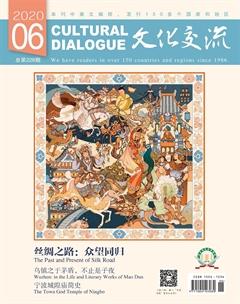钱塘自古产名酒
袁长渭



南宋时,徐村作为京城近郊酒庫,酿酒业特别发达。徐村属于钱塘泗乡范围,这里有九溪留下的好水,有泗乡生产的好粮,有好的烧酒师傅,自然能产出名酒。
老底子人家开门七件事,柴米油盐酱醋茶,七件事里没有酒。我想如是开门八件事,这第八件可能要数酒了。不管你家里喝不喝酒,做菜的调料酒总要有的。
钱塘人家,无论会喝不会喝,每当年脚边,家里总会做些招待客人用的米酒。喜欢喝酒的,那就更不用说了,一缸缸,一坛坛,闻闻都香,看看都有味道。
我父亲滴酒不沾,我哥哥会喝一点。招待亲戚朋友,我家每年都会做一大缸米酒。也就是把饭煮熟,拌上酒药,在大缸里发酵。冬天里,缸的外面要包上稻草,以保证发酵的温度。过年时开缸喝米酒,清澈香甜的米酒,连小孩子都想偷偷地喝一点。我们一帮高中同学过年来我家聚会,油炸年糕干沽酒,喝倒了好几位。米酒就是后劲足,甜味易让人上当。
米酒不能长期存放,时间久了会发酸。做米酒一般都会在冬天,春夏季节时,家里准备的是白酒。
现在,每当我行走在钱塘江大堤上,看到沉甸甸的高粱,就会想起钱塘泗乡的白酒,也就是我们所说的“泗乡茅台”。朋友和学生家长知道我不会喝酒,但请客时时常会用到一些,所以见到五年八年的钱塘陈酿,会帮我送几坛来。打开酒坛,那香味引得我这不喝酒的人都会流口水,直接用酒提子舀来品尝。
《水浒》里的梁山好汉都是大碗喝酒,大块吃肉,武松喝了那么多酒,还居然打死了一只大老虎,我怀疑武松打的是醉拳。据专家分析推论,武松喝的就是我们现在一般人家家里酿的低度米酒,不是度数高的白酒。
钱塘自古就有酿酒的传统,酒业税收还是地方财政的主要保证。据历史记载,南宋首都临安府有13个酒库,钱塘徐村酒库就是其中之一,徐村就是现在的九溪。古代的酒库,就是酿酒厂和酒专卖店的综合体,好比前店后厂。
徐村还有一个闹忙的集市,叫徐村市。每年的清明前酿酒,秋天时开新酒。新酒开卖前,以白布三丈多,用竹竿拉起来做广告,上面写着“徐村库选到酒匠某人酝造上等醲辣无比高酒”,三五个人扶着酒和广告前行。前面还有鼓乐、伎女、杂技做先导,围观的人不计其数。酒匠则戴着新帽穿着紫衣骑着马,跟在广告游行队伍的后面,以府中所赏彩帛、钱会、银碗驼负马前,谓之迎酒。酒以工匠而出名,这也是工匠精神的体现。
南宋诗人杨炎正有《钱塘迎酒歌》:“钱塘妓女颜如玉,一一红妆新结束。问其结束何所谓?八月皇都酒新熟。酒新熟,浮蛆香,十三库中谁最强?临安大尹索酒尝,旧有故事须迎将。翠翘金凤乌云髻,雕鞍玉勒三千骑。金鞭争道万人看,香尘冉冉沙河市。琉璃杯深琥珀浓,新翻曲谱声摩空。使君一笑赐金帛,今年酒赛珍珠红。画楼突兀临官道,处处绣旗夸酒好。五陵年少事豪华,一斗十千谁复校。”为了增加税收,这是好办法。好像我们现在的招商引税,或者说是地块出让广告大会。原来古代就有这样的广告和招商办法。
这里的“新酒熟,浮蛆香”,如果您家酿过酒就知道,新酒飘香时,酒缸里酿酒的饭粒像蛆虫一样漂浮在上面,不是蛆虫,而是像蛆虫样的饭粒。为了打到清澈的米酒,我们都用竹篮过滤。这里讲的酒不是蒸馏酒,都是发酵酒,度数不高。如果您想了解个明白,年底可以去外桐坞村看看古老的酿酒术。
包括徐村库在内的十三库的酒还要进行赛酒大会,比个高低,“今年酒赛珍珠红”,说明那一年的冠军品牌是“珍珠红”。宋朝诗人高翥(余姚人,字九万)有诗云:“赛罢祠山赛二郎,酒行明日欲开张。愚民可是多忘本?香火何曾到杜康!”这里的“祠山”和“二郎”就是当年的名酒品牌吧,好像现在的茅台和五粮液。
南宋时,徐村作为京城近郊酒库,酿酒业特别发达。徐村属于钱塘泗乡范围,这里有九溪留下的好水,有泗乡生产的好粮,有好的烧酒师傅,自然能产出名酒。
现在离徐村不远同属泗乡的双浦地区酿酒业也特别发达,这可能也是传统行业的继承和发扬吧。南宋诗人杨万里在他的诗《过南荡三首(一)》中曾经写道:“秧才束发幼相依,麦已掀髯喜可知。笑杀槿篱能耐事,东扶西倒野酴醾。”诗人到了定山北乡(南荡乡),看到了许多“野酴醾(tú mí)”。“野酴醾”是什么?是一种可以制作酿酒药的花。我小时候经常看到酿酒师傅拿着神奇的酒药拌在糯米饭里,拌匀了捂在酒缸里。这可能就是“野酴醾”制作的。
诸暨人把同山烧酒叫做“诸暨茅台”,钱塘泗乡人把自己酿的酒叫“泗乡茅台”,或者叫“双浦茅台”。品尝陈年的双浦茅台,那醇香味,我看与茅台差不离。
开心时喝酒,唐朝诗人王翰说“葡萄美酒夜光杯”;不开心时喝酒,古人说“何以解忧,唯有杜康”。酒真是好东西。
以后请朋友喝钱塘泗乡茅台,我要先介绍一下她的悠久历史,那可是南宋传下来的名酒哦,相当于南宋时的茅台。钱塘自古产名酒。
Hangzhou is little known for wine making even though villages around the city have been making wine since very ancient times. Back then in rural communities where villagers tried hard to make daily necessities, wine making was a long tradition. Almost every household brew its own rice wine in winter when the Spring Festival was around the corner. My father is a teetotaler, but my big brother drinks a little. To treat visiting friends and relatives around the Spring Festival in those years, our family made a big urn of rice wine every winter. It wasnt difficult to make rice wine. Cooked rice was put into a huge urn and then mixed with yeast. In order to keep the temperature inside the urn right, the urn was wrapped with rice straws. The rice wine was ready for the Spring Festival dinners. The wine was sweet and clear. Even kids wanted to sip some. When I was in senior high, some classmates visited me at my home. We had a good time eating deep-fried slices and drinking homemade rice wine. Some of us got drunk because the wine was deceptively sweet and simple and no one would be aware of the strong delayed effects.
All our neighbors had their own homemade rice wine in winter. As rice wine cant keep when weather becomes warm, we usually make white spirit in spring or in summer for home consumption. We locals in rural Hangzhou enjoy the homemade spirit. Even now some small wineries in Hangzhou make this kind of white spirit.
Hangzhou was a big wine producer in ancient times. During the Southern Song Dynasty (1127-1279), which was housed in present-day Hangzhou, the capital city had 13 wineries. The taxation from the wine-making sector accounted for a big chunk of the total revenue of the capital city government.
Xucun, which is near present-day Nine Creeks, a famous scenic highlight of the West Lake, was home to a winery back then. One f the thirteen wineries of the capital city, the brewery in Xucun was a production and retail complex. Xucun operated a busy marketplace. The wine-making season began before the Qingming Festival in early April and the white spirit would mature until autumn came around. Days before the years new white spirit came on market, some promotional festivities would be held in Xucun. A 10-meter-long white fabric would be set up like a banner with bamboo flagpoles, flaunting the new brew. Moreover, there would be a street parade going through the town and marketplace. Musicians played, acrobats performed, winemakers were on the horseback, wearing new garments.
Extant ancient poems by local people are testimony to the thriving existence of the wine-making industry. From these poems, we can deduce that a wine competition was annually held among the 13 wineries around the capital city during the Southern Song Dynasty. One poem says a wine called Pearl Red won the championship in an annual competition.
In the Southern Song Dynasty, Xucun in an immediate suburb of the city thrived as a wine-making center, largely thanks to the high-quality water of the nine creeks. Today, Shuangpu, a region not far from the creeks, boasts prosperous wineries. Apparently, one generation of loyal local customers after another in the region has enjoyed the local brand. Their support keeps the wineries alive and makes them thrive.

